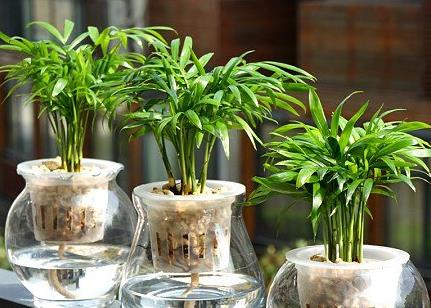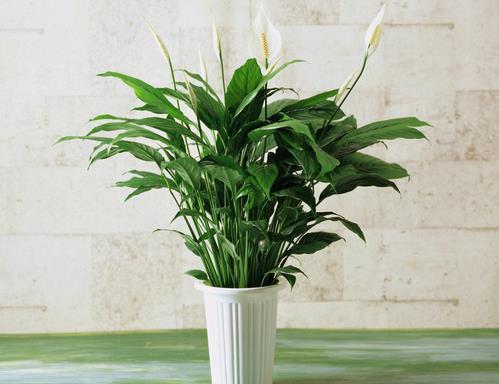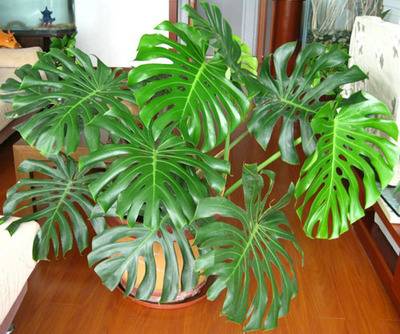What are the breeding methods and points for attention of pocket coconuts?
1. Lighting: pocket coconuts prefer semi-shade, and their leaves will turn yellow in strong sunlight. If placed in places where there is not enough light for a long time, the plants will become thin and long. So it's best to put it in a bright place by the window indoors.
2, temperature: pocket coconut likes to be warm, the suitable temperature for growth is 18 Mel 24 degrees Celsius, 13 degrees Celsius goes into dormancy. It's best not to be less than 10 degrees Celsius in winter.
3. Water: pocket coconuts like water, keep the soil moist during the growth period, and wait until 2/3 of the basin soil is dry during dormancy before watering. In addition, pocket coconuts like high air humidity. If they are too dry, the leaf tips will turn brown. Therefore, during the drying period, such as autumn, measures such as spraying water to the leaves should be taken to improve the air humidity around the plant.
4. Fertilization: compound fertilizer can be applied to the plant once a month during the growing period.
5. Potted soil: the loam with good drainage and loose and fertile soil is the best.
6. Reproduction: pocket coconuts are generally propagated with seeds.

What are the breeding methods and points for attention of pocket coconuts?
In order to raise pocket coconuts, we should also pay attention to the following technical problems:
① beware of focusing edges caused by too much light. Because pocket coconuts prefer a shady environment, indoor cultivation should be placed near the north window, east window or other places with bright scattered light; pocket coconuts are most afraid of direct light, even if exposed to the sun for a short time, it will also cause the leaves to scorch and turn yellow. On the contrary, if it is kept in a dark, dry place for a long time, the color of the leaves will become lighter and lose its luster.
The suitable temperature for ② growth. Generally, the optimum temperature for growth is 20: 30 ℃. In winter, the indoor temperature is between 12 and 14 ℃, and the lowest temperature can not be lower than 10 ℃.
③ maintains the humidity of the surrounding air. It is necessary to spray water on the leaf surface frequently to increase the air humidity.
Acid soil should not be used in ④ basin soil, and a small amount of clay should be added.
⑤ needs to be changed every 3 years.
In the seedling stage of ⑥, the rarefied liquid fertilizer should be applied for 3 to 4 times in spring and spring.
How to grow pocket coconut quickly, the breeding methods and matters needing attention of pocket coconut
Pocket coconut is a plant native to northern Mexico, which is highly ornamental, and there are many people who raise it in our country. However, if you want to raise it well, there are many things you need to pay attention to, so how do pocket coconuts grow fast? What are the breeding methods and matters needing attention of pocket coconut? Next, the editor will take you to learn about it.
First, how to grow pocket coconuts quickly and understand their habits
If we want to know how pocket coconuts grow fast, we must first understand its growth habits. Only if we let it grow in a suitable environment, it will grow better and faster. It likes to grow in a high humidity environment and is not resistant to strong light, so it still needs shading when the light is strong. In addition, watering, fertilization and other aspects also need to be paid attention to. The specific maintenance details are below. Let's move on.
Second, the culture methods and matters needing attention of pocket coconut
1. Potted soil selection, loose, fertile and good drainage
The choice of pot soil is very important for raising pocket coconuts. In flowerpots, we generally choose plastic flowerpots. For soil, it is best to choose relatively loose and fertile humus soil. This kind of soil has high drainage and air permeability, which is not easy to accumulate water and can better absorb nutrients.
two。 Fertilization requirements, once a month during the growing period
Fertilizer is one of the main nutrients in the growth process of pocket coconut, so adequate nutrients are very important if you want to make it grow faster. Especially after entering the growing period, it has a high demand for nutrients, and it basically needs to apply compound fertilizer once a month, so that it can thrive, but when applying fertilizer, we should pay attention to the need to dilute the fertilizer with water first, otherwise it is easy to burn the plant, which we should remember.
3. Temperature management, suitable growth temperature 18-24 ℃
If you want to keep a good pocket coconut, temperature management is also very important, it is suitable for the growth of the environmental temperature of 18-24 ℃, if the temperature is too high or too low is not conducive to its growth, especially in winter, we must do a good temperature control, it is best not to let its growth temperature below 10 ℃, otherwise it is easy to frostbite plants.
4. Watering is required to keep the soil moist but not stagnant
Pocket coconut is a water-loving plant, so it is necessary to keep the soil moist in the process of breeding it, and often spray water on its leaves to maintain the humidity of the air. However, watering also needs a moderate amount, and can not be watered too much, if too much watering causes stagnant water, it is also easy to cause the root to rot, so this degree needs to be controlled.
5. Light management, avoid strong light
Pocket coconuts are not intolerant of strong light, so when we breed them, it is best to put them in a place of sunlight scattering to avoid direct sunlight, and to do a good job of shading when the summer light is too strong, otherwise it is easy to burn plants and cause yellow and dry leaves, so we should pay attention to this.
6. Timely prevention and control of diseases and insect pests
In the growth process of pocket coconut, if the maintenance is not careful enough, it is easy to take advantage of diseases and insect pests and other problems, this kind of problem is very harmful to the plant, if it is not dealt with in time, it will cause plant death. The specific treatment methods in the pocket coconut pest control article has a detailed introduction, interested friends can learn about it.
Culture methods and matters needing attention of pocket coconut what to do if the leaves turn yellow
Pocket coconut, from the name, we can see that this plant has a lot to do with coconut, what are the breeding methods and matters needing attention of pocket coconut? What if the pocket coconut turns yellow?
Cultivation methods and points for attention of pocket coconuts:
Introduction of Pocket Coconut
It is also called dwarf coconut, pocket brown, dwarf brown, flowering in spring, but potted plants basically do not bloom, but its flowers do not have any characteristics, white and green, its leaves are flat, mature plants such as umbrella-shaped, or very elegant.
2. Introduction of growth habits
It likes a warm, humid and semi-overcast environment. The suitable temperature for growth is 20-30 degrees, entering the dormancy period at 13 degrees, and the lowest overwintering temperature in winter is 3 degrees.
1. Soil selection
The cultivation substrate of pocket coconut is well drained, moist and fertile loam. Generally, rotten leaf soil, peat soil, river sand and a small amount of base fertilizer can be used as the substrate for pot cultivation.
It does not have high requirements for fertilizer. In general, liquid fertilizer is applied twice a month in the growing season, with little or no fertilization at the end of autumn and winter. The basin is changed in spring every 2-3 years.
2. Watering and spraying
The principle of pouring cuff coconut water is that it is better to be wet than dry, and the basin soil can always be kept moist. When the air is dry in summer and autumn, you should often spray water on the plants to increase the air humidity of the environment, which is beneficial to its growth, while keeping the leaves dark green and shiny.
Properly reduce the amount of water in winter to facilitate overwintering. Pocket coconuts prefer semi-overcast conditions and avoid direct sunlight in hot seasons.
In the hot sun, the leaf color will become light or yellow, and will produce scorched leaves and black spots, losing ornamental value.
3. Diseases and insect pests
In addition, pocket coconut is prone to social brown spot under high temperature and high humidity. If brown spot is found, it should be prevented and treated with 800Mel 1000-fold topiramate or carbendazim in time.
Scale insects are also easy to occur in dry air and poor ventilation. If shell insects are found, they can not only be scraped manually, but also be sprayed with 800m / 1000 times omethoate.
Third, detailed introduction of daily maintenance
The cultivation substrate is peat, perlite, ceramsite and so on.
After planting, the nutrient solution should be poured thoroughly for the first time until the exudate is seen in the basin bottom tray. Replenish fluid on weekdays, once every 10-15 days; replenish water in time according to the moisture of the matrix, but not on the day of rehydration.
Pour out the exudate from the tray before each replenishment, if there is no disease, it can be recycled, otherwise it should be poured out.
When there is no exudate in the tray, it should be watered in time. It is best to use a small sprinkler for each rehydration or rehydration, and sprinkler irrigation facilities can be set up for large-scale cultivation to spray nutrition directly. This can not only wash the substrate, but also increase the air humidity around the plant, which is conducive to the normal growth of the plant.
IV. Winter maintenance
From October to February of the following year, for the relative dormancy period of pocket coconut (night temperature 12 ℃ 14 min), the amount of water should be controlled to prevent symptoms such as rotting roots, yellow leaves and necrosis caused by too low temperature. Northern winter heating period, room temperature can generally maintain 15-20 ℃ or 25 ℃, when the indoor air is dry, should pay attention to replenish water, it is best to spray water to the leaf once or twice a day, and the flowerpot should not be close to the stove, heating or air conditioner, to prevent acute water loss of leaves, resulting in dry tips, yellow leaves, and even death. In addition, the flowerpot should be placed in a sunny place indoors in winter to facilitate plant photosynthesis.
Introduction to hydroponic culture of nutrient solution
Water culture pocket coconut, is to use nutrient solution cultivation method, pocket coconut likes shady environment, should not be placed near the south window, should be placed in the north, east, west windowsill, or the same place.
The leaves grow dark green in darker places, and turn yellowish green in direct light. Too much strong light can produce scorched leaves and black spots. The optimum temperature for growth was between 20 and 30 ℃, 13 ℃ entered dormancy, and no less than 10 ℃ in winter.
Watering should grasp the principle that it would rather be wet than dry, and keep the basin soil moist all the year round. To properly reduce the amount of water in winter, it is best to irrigate with cold boiled water. You might as well use a clean Rain Water in summer. Often spray water on the leaves and the surrounding ground to maintain high air humidity.
VI. Other maintenance attentions
After leaving the room in spring, you should put it in the shade to avoid direct sunlight, as long as you have brighter light. When the plant is larger, change the pot in time. It has higher requirements for environmental humidity, watering should grasp the principle that it would rather be wet than dry, in order to keep the basin soil moist.
When the air is dry (especially in summer), you should often spray water to the plants to increase the air humidity of the environment. The requirement of fertilizer for this flower and plant is not high. From May to October, cake fertilizer and water should be applied twice a month.
Hydroponic maintenance:
1. Avoid direct sunlight, otherwise the leaves will become withered and yellow, but the color of the leaves will be light when they are too overcast.
2. The plant shape of pocket coconut is the most beautiful when it is 30cm to 50cm. When the plant is too high, the ornamental value will be reduced because the lower part of the coconut is empty. Small plants can be cultivated below when planting.
3. The acquisition of hydroponic materials: the pot root washing method was adopted. New roots can grow in a few days after washing.
According to the current nutrient solution configuration, most plants can be hydroponically cultured, but they need careful care, otherwise it is easy to let flowers die because of nutrition!
6. When raising pocket coconuts, attention should be paid to:
① beware of focusing edge caused by too much light
Because pocket coconuts prefer a shady environment, indoor cultivation should be placed near the north window, east window or other places with bright scattered light.
Pocket coconut is most afraid of strong light, even if it is exposed to the sun for a short time, it will cause the leaves to scorch and yellowing. On the contrary, if it is kept in a dark, dry place for a long time, the color of the leaves will become lighter and lose its luster.
② optimum temperature
Generally, the optimum temperature for growth is 20: 30 ℃. In winter, the indoor temperature is between 12 and 14 ℃, and the lowest temperature can not be lower than 10 ℃.
③ maintains ambient air humidity
It is necessary to spray water on the leaf surface frequently to increase the air humidity.
Acid soil should not be used in ④ basin soil, and a small amount of clay should be added.
⑤ needs to change the basin every 3 years.
Change the basin every 2-3 years in spring to facilitate growth. Because the cuttage of pocket coconut is not easy to survive, it is mainly propagated by sowing method.
In the seedling stage of ⑥, the rarefied liquid fertilizer should be applied for 3 to 4 times in spring and spring.
The root system of pocket coconut is slender, so it is appropriate to choose loose and fertile culture soil, and heavy clay is easy to cause rotten roots.
Because it likes a more shady environment, indoor training should be placed near the north window, east window or other places with bright scattered light.
Pocket coconut is most afraid of strong light, which is exposed to the sun for a short time, which will also cause the leaves to scorch and turn yellow. On the contrary, if placed in a dark place for a long time, the leaf color will become lighter and the glossiness will be weakened.
Summer watering should be adequate, and often spray water on the leaf surface to increase air humidity. In order to meet the needs of indoor viewing, the plant height had better be controlled between 40 cm and 60 cm, so fertilization should not be too much.
In general, in the seedling stage, the dilute liquid fertilizer should be applied 4 times in spring and autumn. The best ratio of nitrogen to phosphorus in fertilizer is 1.5 to 1.2. This ratio can not only make the stem strong, but also improve the leaf glossiness.
What if the pocket coconut leaves turn yellow?
If you want to lose, the leaves of the pocket coconut turn yellow, so take the pocket coconut out to bask in the sun and don't pour too much water.
This is the end of the introduction on the planting method of pocket coconut and the treatment of yellowing leaves. Why not raise one plant as soon as possible.
- Prev

What is the breeding method of white palm? What if the leaves of white palm droop?
White palm is loved by new consumers because of its simple maintenance and elegant style. In addition to it is called white palm, it can also be called white taro, it is a very good ornamental plant. Do you know the culture method of white palm? What are the matters needing attention in the breeding of white palm?
- Next

What are the breeding methods and matters needing attention of tortoise back bamboo?
We can always see all kinds of potted plants in the homes of florists, and tortoise-backed bamboo is one of them. It is a famous foliage plant, suitable for potted plants. It is widely cultivated indoors for decoration and ornamental purposes.
Related
- Fuxing push coffee new agricultural production and marketing class: lack of small-scale processing plants
- Jujube rice field leisure farm deep ploughing Yilan for five years to create a space for organic food and play
- Nongyu Farm-A trial of organic papaya for brave women with advanced technology
- Four points for attention in the prevention and control of diseases and insect pests of edible fungi
- How to add nutrient solution to Edible Fungi
- Is there any good way to control edible fungus mites?
- Open Inoculation Technology of Edible Fungi
- Is there any clever way to use fertilizer for edible fungus in winter?
- What agents are used to kill the pathogens of edible fungi in the mushroom shed?
- Rapid drying of Edible Fungi

